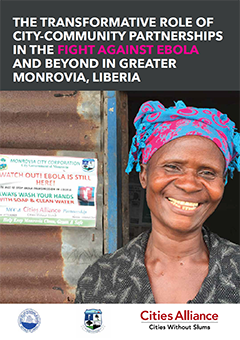[30 January 2017] -- The Cities Alliance partnership commissioned The Transformative Role of City-Community Partnerships in the Fight Against Ebola and Beyond in Greater Monrovia, Liberia to document a significant knowledge gap on how the partnerships between communities and local government contributed to the eradication of Ebola in Monrovia.
The Cities Alliance was introduced to Monrovia when it was requested to act as the substantive intermediary between the Monrovia City Council and the Bill & Melinda Gates Foundation, which financed the Improved Primary Waste Collection in Poor Communities (IMPAC) project. This initiative eventually laid the foundation for the Cities Alliance Liberia Country Programme.
What began as an oversight function of a well-designed, important project was transformed by the impact of the Ebola Virus Disease, not only in Monrovia, but throughout Liberia, Sierra Leone, and Guinea in the largest and most devastating Ebola outbreak in modern history, claiming over 11,000 lives. Ebola also provided a huge setback to the Liberian economy, which was finally beginning to emerge from a crippling civil war.
This crisis was unique in that it was the first-time Ebola hit major urban centres in Africa, magnifying its impact and, as this report shows, providing important insights as to how local and collaborative approaches can succeed where traditional responses are shown to be hopelessly inadequate.
In this respect, Monrovia shares many features of African cities, with overburdened and extremely basic urban services, a dysfunctional land market with little access or tenure security for the urban poor majority, and an enormous reliance on a poorly-understood informal market.
Poorer neighbourhoods in Liberia’s capital were linked to more intense, widespread transmission of Ebola, compared to more well-off parts of Monrovia, a pattern seen with other infectious diseases. It has been estimated that some 75 percent of victims in Liberia were women and girls because of their role as primary care givers.
Liberia’s strategy shifted in 2015 from a top-down approach resulting in the forced quarantine of slum communities in Monrovia to a decentralised response engaging urban poor communities and local authorities in partnership. This move played a key role in turning the trajectory on new Ebola infections in the city.
Now, Liberia’s response is a success story, serving as a vital lesson for African cities undergoing rapid urban growth.
The report found that in Liberia’s urban slums, strong community networks were enlisted to help battle the disease. These networks were functional—and indeed, transformational—despite the infrastructure problems.
This in turn facilitated government efforts to engage communities to help overcome the crisis.
Cities Alliance hopes this report contributes to a better understanding and appreciation of the vital importance of these partnerships, not only for future infectious disease outbreaks, but for crises of all kinds.

Liberia’s response to Ebola is a success story, serving as a vital lesson for African cities undergoing rapid urban growth.
Related Items:
Cities Alliance Liberia Country Programme
President of Liberia Calls Cities Alliance Programme a Breakthrough for the Country
Turning Trash into Community Development in Liberia’s Capital Monrovia
Comic Relief and Big Lottery Fund Partner with Cities Alliance to Create Lasting Change in Liberia
Monrovia City Corporation’s Slum Initiative
How Local Authorities and Communities Worked Together to Fight Ebola in Monrovia




